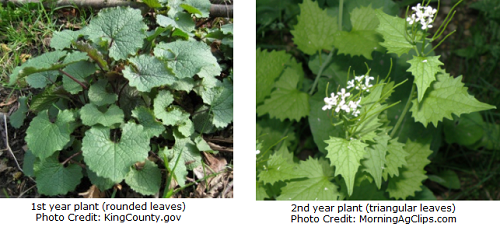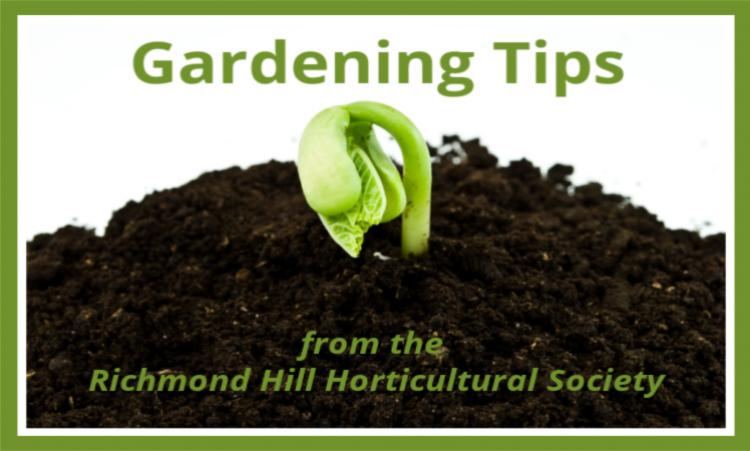Submitted by Monica Ahrens, a member of the Richmond Hill Garden & Horticultural Society
Writing about the invasive Garlic Mustard was to be a simple, therapeutic way to share my daunting experience of discovering and attempting to eradicate this aggressive plant. I had noticed it with increasing frequency on my mother’s country property a few years ago, and now in my small urban garden, which backs onto woodland. Beware, my friends, it likely lurks in your favourite green spaces as well.
As I undertook further research on this green beast, I recognized that writing about it was not to be simple at all. Its threat to our biodiversity is astounding, and its management quite complex. There is much that I discovered about the invasive Garlic Mustard. I will offer some notables, as well as some suggested links for additional information.
Garlic Mustard is a biennial (2-year life cycle) herbaceous plant in the mustard family, native to Europe. It was apparently introduced to North America as a food source and used as herbal medicine by settlers in the late 1800s. It, unfortunately, escaped cultivation to become a serious invader in Ontario.
Make the time to recognize it. It will look different in each of year one and year two. For more details, Ontario’s Invading Species Awareness Program1 offers excellent resources, including photographs, a fact sheet, and management practices.

First-year plants are low-growing rosettes with rounded, kidney-shaped leaves, scalloped on the edges. On mature plants, the upper leaves are more triangular, becoming smaller toward the top of the plant. The leaves have noticeable veins and deeply toothed edges. At the top of the plant will be one stem that flowers with a cluster of small white flowers, when blooming in the spring. Depending on when you find the garlic mustard, it may also have lots of thin seedpods. The giveaway for Garlic Mustard is the smell. The stems, leaves, and flowers smell like garlic, especially when crushed. The flowers attract pollinators, which is why, sadly, some have suggested introducing this plant to your garden…. oh oh, and oh no!
Garlic Mustard is hugely damaging to our environment:
- It commonly grows in urban gardens and woodlands and carries diseases like mosaic viruses which may affect other garden plants
- It is a nuisance for dairy farmers because when eaten by livestock, the garlic flavour can be tasted in the milk, making it unusable.
- It releases chemicals that change soil chemistry and prevent the growth of other plants.
- It can establish itself and become the dominant plant in a forest understory within 5-7 years. It displaces native woodland plants and wildflowers, many of which are now listed as species at risk, through competition and/or through changes to the soil and leaf litter.
How do we control this green beast? I felt quite proud that I must have eradicated at least 3000 of these plants over the last few weeks. However, work is still ahead for me. These plants are so adaptable, they anticipate how we want to deal with them!
My first thought was to take the weed wacker to them! Oh oh! This is called basal cutting. Basal cutting involves cutting 2nd-year plants at the base of the stem. The best time to do basal cutting is just after the plant's flower, and before they produce seeds. Garlic Mustard plants can flower at different times but typically from March to May, so it will need to be repeated more than once in a season. Plants that have been mowed can still send up flowering stalks, but continuous mowing throughout the growing season can prevent seed production. Basal cutting is preferable to hand pulling because it reduces soil disturbance.
Hand pulling is a practical strategy for small populations. However, pulling Garlic Mustard by hand creates soil disturbance, which stimulates the germination of seeds. Seeds can stay dormant over winter and remain viable in the soil for up to five years! If you elect to pull, do so from the base, to remove the entire root. If Garlic Mustard roots are damaged but not removed, small buds on the roots will sprout additional stems. They are then able to produce replacement flowers, as late as July and August. Once they go to seed, plants can produce up to 150 seed pods, with up to 22 seeds per pod! Oh oh! Hand pulling must be repeated more than once. So, here I go again…
Control measures must be continued for at least 5 years to ensure that the seed bank is depleted. It is important to remove both stages, 1st and 2nd-year plants, as removal of only the tall flowering plants may reduce competition to the basal rosettes, increasing their chances of survival and flowering in the next year. It ain’t over until it’s over! If an area is cleared of Garlic Mustard plants, it should be re-planted immediately with other plants or covered with leaves or mulch at least 5cm thick to reduce its seed germination success.
Back to the initial food source reference, many rave about garlic mustard pesto. I make the traditional basil pesto but have never tried to make the garlic mustard pesto which is likely because my feelings about this green plant aren’t so flavourful. There are many recipes out there.
Garlic Mustard is invasive and hard to get rid of once it enters your garden. That makes it something to be concerned about. Whether you choose to chop it, clip it, pull it or puree it, we all appreciate your vigilance in controlling this green beast and protecting our environment.
- Ontario’s Invading Species Awareness Program << http://www.invadingspecies.com/invaders/plants/garlic-mustard/
- Ontario Invasive Plant Council << https://www.ontarioinvasiveplants.ca/
- King County. Garlic mustard identification and control. Alliaria Petiolata >> https://kingcounty.gov/services/environment/animals-and-plants/noxious-w...
- Morning GA Clips. Managing Garlic Mustard https://www.morningagclips.com/managing-garlic-mustard/
- Friends of the Mississippi River (Twitter). How to Identify Garlic Mustard << https://twitter.com/FriendsMissRiv/status/1231999116198207488/photo/1









